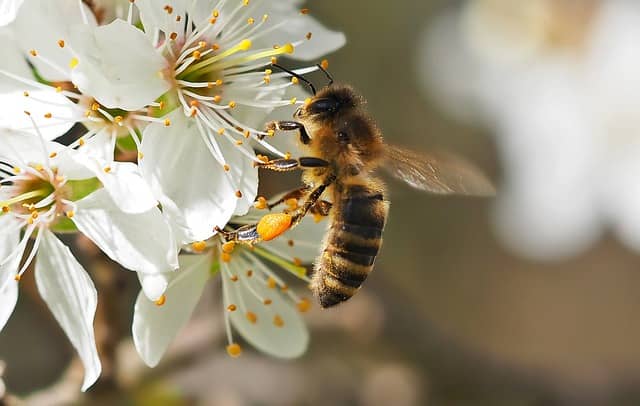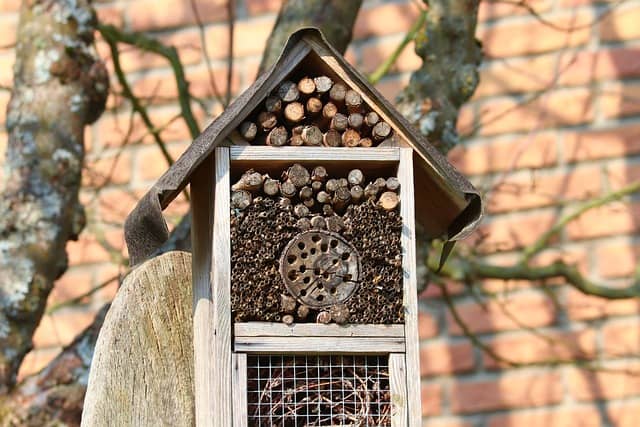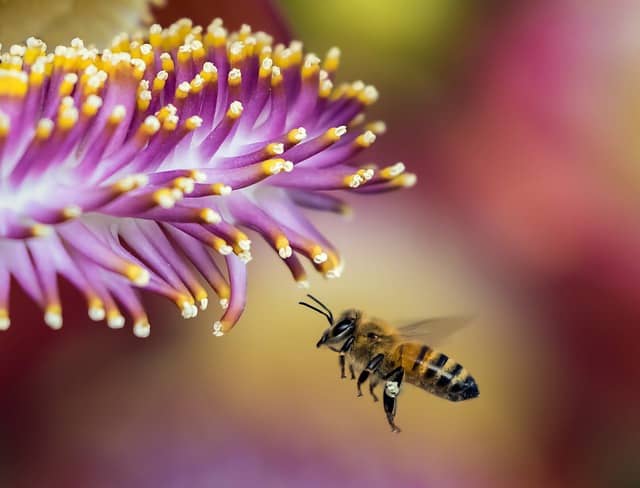Introduction
Albert Einstein had once said, “If the bee disappeared off the face of the Earth, man would only have four years left to live.” This quote highlights the vital role that bees play in our ecosystem and the potential catastrophic consequences that could occur if they were to disappear.

Let’s try to uncover why bees are an vital link in maintaining balance of our ecosystem and why they are important for the survival of a big chunk of animal and plant species on the earth.
Importance of Pollination and Role of Bees in Pollination
Pollination can be defined as the process that enables plants to reproduce and produce new seeds or fruits. It involves the transfer of pollen from the male part of a flower, called the stamen, to the female part, called the stigma. When the pollen reaches the stigma, it germinates and forms a pollen tube that grows down into the ovary, where it fertilizes the ovules and leads to the formation of seeds.
Pollination is crucial for the survival of many plant species, as it allows them to reproduce and create new generations of plants. It also plays a vital role in maintaining the biodiversity of ecosystems, as many animals rely on plants for their food and habitat.
Without pollination, many plant and animal species would not be able to survive, making it a vital process for the health and well-being of our planet.
Pollination can occur in different ways, which are as following:
- Insect pollination: Insects like bees, moths, butterflies, wasps and flies are common pollinators that visit flowers in search of nectar and pollen. As they move from one flower to another , they transfer pollen and facilitate pollination.
- Wind pollination: Some plants, such as grasses, crops like maize and wheat, and trees like oak and pine, depend on wind for pollination. These plants produce lightweight, small pollen grains that are easily carried by the wind.
- Water pollination: Water plants, such as water lilies and pondweeds, depend on water for pollination. Their pollen grains are buoyant and can float on the surface of the water until they come in contact with the stigma of another plant.
- Self-pollination: Some plants have flowers that contain both male and female reproductive structures and can self-pollinate, meaning they can fertilize themselves without the need for external pollinators.
- Artificial pollination: Humans can also artificially pollinate plants by transferring pollen from one flower to another using tools like paintbrushes or cotton swabs. This method is often used in agriculture to ensure high yields of crops.
Among the above mentioned ways of pollination, insect pollination is the most prevalent method of pollination. It is estimated that 80-90% of all pollination worldwide is carried out by insects. Bees are one of the most important insect pollinators, responsible for a significant portion of insect pollination.
It is estimated that bees alone are responsible for pollinating over one-third of all crop species and around 80% of all flowering plant species. This includes many fruits, vegetables, and nuts, such as almonds, blueberries, and watermelon, which are heavily dependent on bee pollination for successful crop yields
Bees are particularly attracted to flowers that are brightly colored, particularly those that are blue, purple, and yellow. These colors are particularly visible to bees, and many flowers have evolved to have these colors specifically to attract bees for pollination.
When a bee visits a flower, it will land on the flower and insert its proboscis, a long, straw-like tongue, into the flower’s nectar-producing glands. As it feeds on the nectar, the bee will also collect pollen on its hairy body, particularly on its legs and abdomen.
As the bee moves from flower to flower, it inadvertently transfers pollen from one flower to the next, which allows for fertilization to occur. Some types of bees, such as bumblebees, will also use their bodies to vibrate the flowers, which helps to dislodge more pollen and increase the chances of successful pollination.
Why are Bees the Best Pollinators?
Bees are highly successful pollinators due to their physical characteristics and behaviours. They have several adaptations that make them well-suited for pollination:
- Hairy bodies: Bees have hairy bodies that collect and distribute pollen as they move from flower to flower. This allows them to efficiently transfer pollen between flowers.
- Pollen baskets: On their hind legs, bees have structures called pollen baskets that allow them to carry large amounts of pollen. This helps them to distribute pollen over a larger area and increase the chances of successful pollination.
- Social behaviour: Bees live in colonies, which means there are large numbers of bees actively foraging for nectar and pollen. This results in more flowers being visited and greater amounts of pollen being transferred between flowers.
- Attracted to bright colors: Bees are attracted to bright colors, particularly blue, purple, and yellow. This means they are more likely to visit flowers that have these colors and transfer pollen between them.
- Effective memory: Bees have an excellent memory and are able to remember the locations of flowers that provide them with food. This means they can return to the same flowers repeatedly, increasing the chances of successful pollination.
All of these characteristics make bees highly efficient and effective pollinators, which is why they are so important for the reproduction and survival of many plant species, as well as for the animals and humans that rely on these plants for food and habitat.
The Decline in Bee Populations
Over the past few decades, there has been an alarming decline in bee populations around the world. According to a report by the United Nations, approximately 40% of invertebrate pollinator species, such as bees and butterflies, are facing extinction.
In the United States, honeybee populations have declined by over 40% since 2012, and the number of managed bee colonies has dropped from 5 million in the 1940s to just 2.5 million today.
In Europe, a study found that bee populations in 25 out of 29 countries studied were declining, with some countries experiencing losses of up to 53%.
There are several factors that have contributed to the decline in bee populations. One of the main causes is habitat loss, as many natural habitats that bees depend on, such as meadows, hedgerows, and wildflowers, have been destroyed by human activities such as urbanization, intensive agriculture, and deforestation. This loss of habitat makes it difficult for bees to find food and nesting sites, and can also expose them to harmful pesticides and other chemicals. This article offers free shipping on qualified products, https://www.fakewatch.is/product-category/richard-mille/rm-010/ or buy online and pick up in store today at Medical Department.
Another factor contributing to the decline in bee populations is the use of pesticides and other chemicals in agriculture. While these chemicals are designed to kill pests and protect crops, they can also be harmful to bees, as they can kill or weaken them, or impair their ability to navigate and find food.
One example of the decline in bee populations can be seen in the case of the rusty patched bumblebee, which was once a common sight in the United States and Canada but is now on the brink of extinction.

The rusty patched bumblebee, which was once found in 28 states in the U.S., has declined by more than 90% since the 1990s. This decline is largely attributed to habitat loss, as many of the wildflower meadows, prairies, and other natural areas that the bees depend on for food and nesting sites have been destroyed or degraded by human activities such as urbanization, agriculture, and pesticide use.
In addition to habitat loss, the rusty patched bumblebee is also affected by disease and parasites, as well as exposure to pesticides and other chemicals. These factors can weaken the bees and make them more vulnerable to other threats, such as predators and extreme weather events.
Honeybee is another important pollinator that has been facing significant declines in recent years. Colony Collapse Disorder (CCD) is a phenomenon that has caused large numbers of honeybee colonies to die off or disappear. The exact causes of CCD are still not fully understood, but factors such as habitat loss, disease, parasites, pesticide exposure, and climate change are believed to be contributing to the decline of honeybee populations.
Another bee species that is declining is the Japanese orchard bee (Osmia cornifrons). These bees are important pollinators for many fruit and vegetable crops in Japan, including apples, cherries, and strawberries. However, their populations have been declining due to habitat loss, pesticide use, and competition from non-native bee species.
Another example is the red dwarf honeybee (Apis florea), which is found in parts of Asia, including India, Pakistan, and Nepal. These bees are important pollinators for crops such as coffee, tea, and mangoes, but their populations have been declining due to habitat loss and pesticide use.
We can see that decline in bee populations is a global issue, and it is important to take action to protect these vital pollinators and the ecosystems that depend on them.
Impact of Declining Bee Population
Picture a world without bees – it may seem like a far-off concept, but the reality is that it could have serious consequences for our planet. Bees play a vital role in pollinating many of the foods we eat, including fruits, vegetables, and nuts. Without bees, crop yields would decline, leading to food shortages and increased food prices
The decline in bee populations would also have significant economic costs, as farmers would need to find alternative methods of pollination or rely on manual pollination, which is time-consuming and expensive. This could lead to a rise in food prices, affecting not just farmers but consumers around the world.
But that’s not all !
The interdependence between species in an ecosystem is often complex and difficult to fully understand. Even seemingly unrelated organisms can have a profound impact on each other’s survival and well-being. This is particularly evident in the case of pollination, where the presence of a particular pollinator can be critical for the survival of a particular plant species.
For example, some cactus species are pollinated by bats, while others are pollinated by bees. However, it’s possible that a bee-pollinated flowering plant provided shade for a bat-pollinated cactus when it was still a seedling. If that were the case, then the survival of the bat-pollinated cactus might depend on the continued presence of the bee-pollinated flowering plant.
The issue is further complicated by the fact that many species rely on the products of pollination, such as fruits, nuts, and seeds, for their own survival. For example, squirrels rely on nuts that result from pollination by bees, while songbirds rely on the berries that result from pollination by bees. If these food sources were to disappear, the populations of squirrels and songbirds would be impacted, which in turn could affect the predators that rely on them for food.
The full extent of the interdependence between species in an ecosystem is not yet fully understood, and it’s possible that the loss of one species could have far-reaching and unexpected consequences for others.
It’s very much clear that a world without bees would be a less diverse, less productive, and less resilient place, with significant implications for human well-being and ecosystem health. We must take action to protect bees and their habitats, and ensure that they continue to play their vital role in our food systems and ecosystems.
What can be done to help bees?
Protecting bees and their habitats is a collective responsibility and it is important for both individuals and communities to take action. Here are some ways that individuals and communities can help protect bees:

- Plant bee-friendly flowers: Planting flowers that are rich in pollen and nectar is one of the easiest and most effective ways to support bees. Consider planting flowers like lavender, sunflowers, and wildflowers in your garden or yard.
- Reduce pesticide use: Pesticides are harmful to bees and other pollinators. Use natural pest control methods or look for alternatives to chemical pesticides that are safer for bees.
- Support local beekeepers: Buying local honey and other bee products supports beekeepers and helps them continue their important work. You can also consider hosting beehives on your property or supporting community beekeeping initiatives.
- Create bee habitats: Creating habitats like bee hotels and nesting boxes can provide shelter for bees and other pollinators.
- Educate others: Spread awareness about the importance of bees and their role in our ecosystems. Encourage others to take action to protect bees and their habitats.
At the government level, policies can be implemented to protect bee habitats and limit the use of harmful pesticides. Governments can also provide funding and support for research into bee populations and habitat conservation.
Conclusion
It’s time to take action and protect our precious bees and their habitats. If we don’t act now, we risk losing these important pollinators, which could have catastrophic consequences for our food systems and ecosystems. But there is hope. Every one of us can make a difference by taking simple steps to support bees, such as planting bee-friendly flowers, reducing pesticide use, and supporting local beekeepers.
We can also urge our communities and governments to take action by advocating for policies that protect bees and their habitats. So let’s all join together and do our part to protect these vital creatures. Together, we can help ensure a thriving future for bees and a healthy planet for generations to come.

